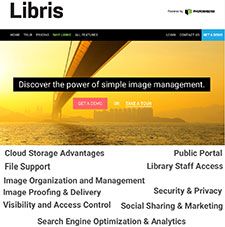
New York, NY—PhotoShelter, a leader in cloud-based image asset management, launched Libris—an affordable system designed to empower organizations to efficiently and securely organize, manage, access and collaborate with their visual assets.
As the need for visual content continues to escalate, PhotoShelter leveraged its 10 years of industry experience to identify the pain points that prevent people from harnessing their images—from pricey DAM solutions to countless hours lost searching for images scattered across an organization.
With feedback and collaboration from more than 70 large businesses, Libris was developed to allow organizations to implement robust image asset management in just a few hours.
“We have enjoyed 10 years of success in providing the industry’s most widely used platform for professional photographers to manage their images, and now we’ve built upon that experience to create a tailored solution for larger companies,” said Andrew Fingerman, CEO of PhotoShelter. “Our vision is to help brands participate in the massive trend toward using visual content to engage and connect with their audience—to speak the language of photography. Libris empowers brands and businesses, teams and workgroups to manage, access and use their images quickly and easily.”
The Libris image asset management solution offers flexible capabilities to adapt to any organization’s workflow. It helps streamline the way that creative, marketing and communications teams work with images by delivering a centralized image database with advanced search options. It also offers access controls and download permissions to customize how each end user or group interacts with visual assets. And leveraging built-in anti-theft capabilities, it prevents unauthorized downloads and usage.
Libris includes the ability to upload images from multiple contributors to one central location with authorized administrators able to organize image collections and grant user permissions centrally. Users can archive and store original, high-res images in any format, online, in secure cloud storage, while extensive metadata management capabilities enable them to sort and search photos by file name, photographer, keyword, caption or attributes like date, location and model/property release.
Users can also create websites for stakeholder search and access; sell or license visual assets with a built in e-commerce engine; monitor access and individual user download activity, track image downloads with logs and analytics; and leverage permission controls to restrict sensitive content with passwords and user logins, anti-theft measures, and image redundancy across servers in multiple geographic locations.





